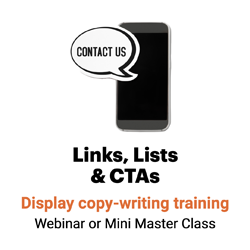Concrete headlines easier to understand, more memorable
Two professors from Texas A&M University and one from the University of the Andes aimed to find out whether concrete or abstract information was more:

- Understandable
- Memorable
- Interesting
First, the professors crafted a series of passages. Each passage was about 56 words long; all were written at about the same level of readability. Half the passages were abstract; the other half, concrete.
Next, they wrote a series of abstract and concrete headlines, including:
Abstract headline |
Concrete headline |
| Domestic Devices | Countertop Gadgets |
| Preferred Items | Favorite Junk |
| The Laws of Lift | How a Plane Flies |
| A Science Find | Jungles in Ice |
| Mortal Justice | Death Penalty |
Then they asked 40 graduate students to read the headlines and rate them on such qualities as how interesting and easy to understand they were.
The students rated the concrete headlines much more interesting and understandable.
Concrete headlines, copy more memorable.
Finally, the researchers had another group of graduate students read the copy and headlines. After time had passed, researchers asked the students what they’d read.
The students remembered:
- Concrete text with concrete headlines best of all
- Concrete text with abstract headlines second best
- Abstract text, regardless of headline, least
In fact, the students remembered the concrete text 70% better than the abstract text.
Bottom line: Concrete material is more understandable, more interesting and easier to remember than abstract information.
The researchers write: “Using more concrete language and content should have positive effects in making … text more comprehensible, interesting and memorable.”
Readers prefer feature headlines.
Readers prefer feature headlines — like “The Smell of Corruption, the Scent of Truth” or “Face to Faith” — according to a 2009 study by researchers at the University of Athens.
Not only did participants rate the feature heads more interesting, they also said they’d be more likely to read the stories.
But wait! There’s more! A catchy headline tops the list of elements that convince readers to read, according to a 2012 Harris Interactive Poll.
Write good headlines like the Times.
No wonder more than one in 10 New York Times headlines is a feature head. (This technique is not just for online dating sites.)
We analyzed 99 headlines in a single edition of the Times. (We skipped the sports pages.) Of those, 12 — about 12% — were feature headlines.
Steal a tip from the Times, and write headlines like these:
Riches to Rags for New York Teenager Who Admits His Story Is a Hoax
Stuyvesant High School Student Now Says He Didn’t Make $72 Million on Stocks
And:
The Odd Math of Medical Tests: One Scan, Two Prices, Both High
And:
Instead of Tenants, It’s Cats, Trash and Little Progress for Brooklyn Project
Clever copy isn’t just for dating profile headlines and ads on how to lose weight. Your readers will find themselves falling in love with clever headlines for social media, blog posts and other messages. Try strong action words and other feature headline techniques.
How can you surprise and delight readers with great headlines?
____
Source: Mark Sadoski, Ernest T. Goetz and Maximo Rodriguez, “Engaging Texts: Effects of Concreteness on Comprehensibility, Interest, and Recall in Four Text Types,” Journal of Educational Psychology 92, 2000, pp. 85-95

Leave a Reply